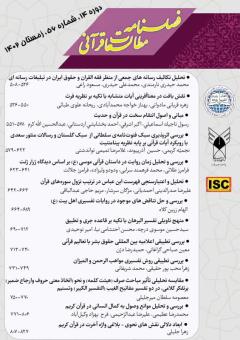-
-
List of Articles
-
Open Access Article
1 - Study and analyzing the obstacles to achieving humanperfection in the Holy Qur'an
mohammadreza azimi alireza abdorrahimi faraj behzad -
Open Access Article
2 - The role of texture in similar verses on the Theory Firth
Zohreh Ghorbanimadavani behnaz khajeh mohammad abadi reyhaneh alavi tabaei -
Open Access Article
3 - Analysis and validation of the list of Ebn Abbas in the order of revelation of the surahs of the Quran
Alireza Sadreddiniahmadiani mojgan sarshar Maryam Hajiabdolbaghi -
Open Access Article
4 - The investigation and analysis of the narration time in the story of Moses (PBUH) from the perspective of Gérard Genette's theory based on the Quran
faramarz talaei mohammad farahmand sarabi vododo valizadeh faramarz jalalat -
Open Access Article
5 - مبانی و اصول انتقام سخت در قرآن و حدیث
رسول تاجیک akbr ashrafi ahmad bakhshayeshi hosein allakaram -
Open Access Article
6 - بررسی و حل تناقضهای موجود در روایات تفسیری اهل بیت (ع) (مطالعة موردی: تفسیر نورالثقلین)
elham zarinkolah -
Open Access Article
7 - The interpretative method of interpreting al-Borhan based on the principle of implementation and adaptation
seyed hossein moosavi dorcheh Mohsen Ehteshminia amir tohidi -
Open Access Article
8 - Analytical comparison of the grammar (word structure) and syntax (adopting the meaning of letters and referencing pronouns) influence on speculative theology in two commentaries of Mufatih al-Ghaib (Al-Tafsir al-Kabir) and Tasnim
Masome Soltan Mirjalili Mohamad Reza Amin -
Open Access Article
9 - Investigating the effectiveness of Soltani's fatutnameh style from the style of Golestan and Saadi's prose treatises with the approach of Quranic verses based on the theory of intertextuality
Najmiyeh Karimi Hossein Azarpivand Gholamreza Tamimitavandashti -
Open Access Article
10 - Analysis of the duties of mass media from the perspective of Quranic jurisprudence and Iranian law in media propaganda
mohammad heidari narmandi Mohammad Ali Heidari masoud rae -
Open Access Article
11 - Comparative study of the interpretation method of Mohabe Rahman and Al Mizan
zahra mohebpoor haghighi mohammad sharifani -
Open Access Article
12 - A comparative study of the International Declaration of Human Rights with Quranic teachings
moein sabahi goraghani Hamidreza Dejan -
Open Access Article
13 - Semantic dimensions of the Syntactic-rhetorical roles of the word hereafter in the Holy Quran
Zahra Jalili
-
The rights to this website are owned by the Raimag Press Management System.
Copyright © 2021-2025







